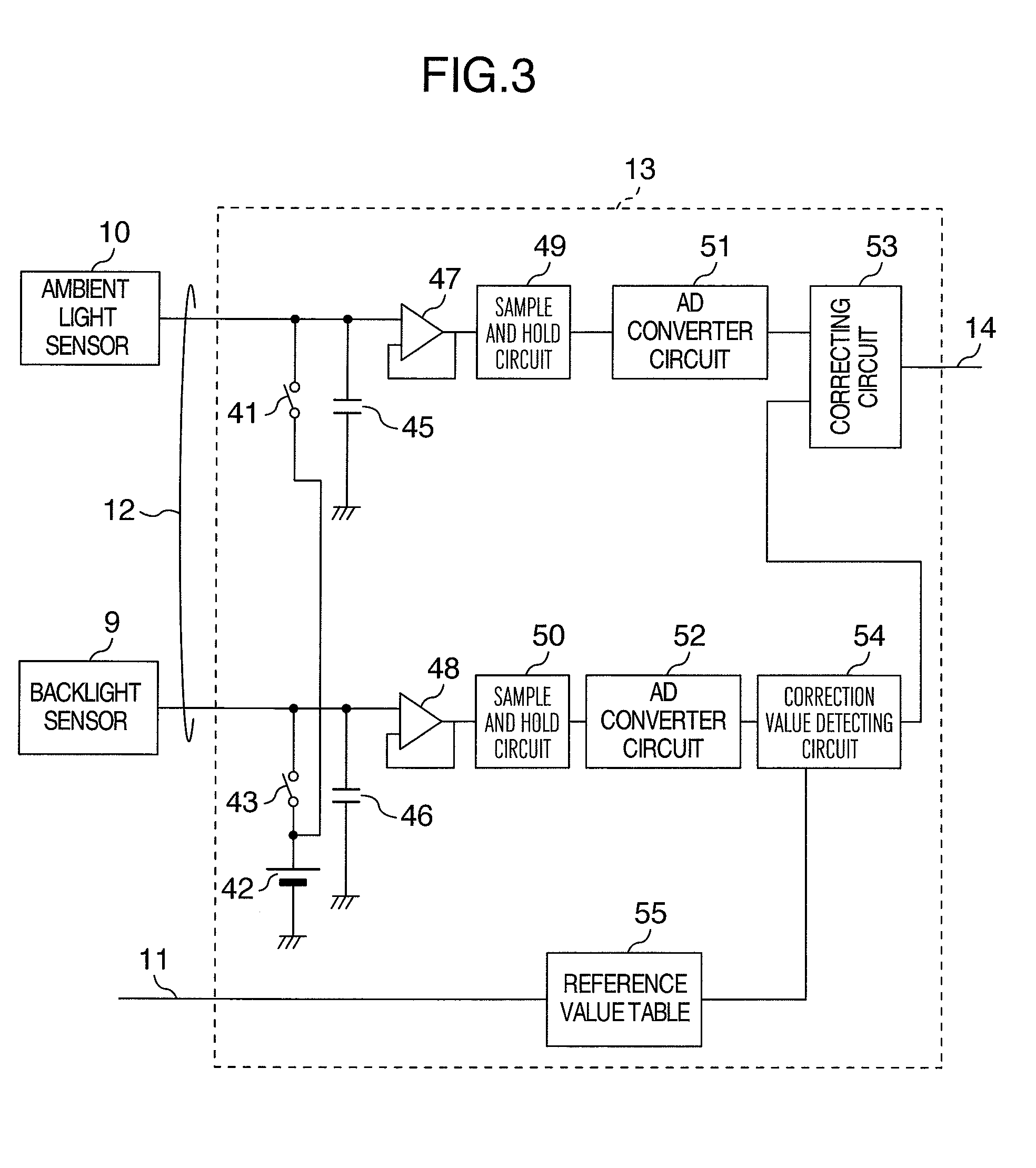Display Device
- Summary
- Abstract
- Description
- Claims
- Application Information
AI Technical Summary
Benefits of technology
Problems solved by technology
Method used
Image
Examples
first embodiment
[0030] The first embodiment of the present invention will be described with reference to FIGS. 1 to 6.
[0031]FIG. 1 is a block diagram showing a liquid crystal display device according to the present invention. A numeral 1 denotes a controller, a numeral 2 denotes display data, a numeral 3 denotes a control signal, a numeral 4 denotes a scan line drive circuit, a numeral 5 denotes a signal line drive circuit, a numeral 6 denotes a liquid crystal panel, a numeral 7 denotes a backlight module, a numeral 8 denotes a light sensor pair formed in the liquid crystal panel 6, a numeral 9 denotes a backlight sensing means (backlight sensor) of the light sensor pair 8, a numeral 10 denotes an ambient light sensing means (ambient light sensor) of the light sensor pair 8, a numeral 11 denotes light modulation setting data (to be used for setting a light modulation level), a numeral 12 denotes a light sensor output, a numeral13 denotes a sensor output control circuit, a numeral 14 denotes a corr...
second embodiment
[0059] The second embodiment of the present invention will be described with reference to FIG. 7. The display operation of the liquid crystal display device and the light modulation control to be executed through the light sensors are the same as those described with respect to the first embodiment. The sectional structure of the light sensor pair 8 of the second embodiment is different from that shown in FIG. 2.
[0060]FIG. 7 shows a partial sectional structure of the light sensor pair 8. The difference of the structure shown in FIG. 7 from that of the first embodiment shown in FIG. 1 is a backlight shading film 31a and an ambient light shading film 33a. The film 31a is located outside of the lower glass substrate 37 and the film 33a is located outside of the upper glass substrate 34. The location of these light shading films outside of the glass substrates makes it possible to reduce the manufacturing cost of the liquid crystal panel.
third embodiment
[0061] The third embodiment of the present invention will be described with reference to FIG. 8. The display operation of the liquid crystal display device and the light modulation to be executed through the light sensors are the same as those described with respect to the first embodiment. The difference between the third embodiment and the first embodiment is location of the light sensor pair 8 shown in FIG. 2.
[0062]FIG. 8 shows a partial sectional structure of the light sensor pair 8 including an ambient light sensor 70, a backlight shading film 71, a backlight sensor 72, an ambient light shading film 73, an upper glass substrate 77, a color filter 75, a liquid crystal layer 76, a lower glass substrate 74, and a backlight unit 78. The difference of this structure shown in FIG. 8 from that of the first embodiment shown in FIG. 2 is a TFT element formed on the side of the upper glass substrate 77.
[0063] Since the ambient light sensor 70 is located on the upper glass substrate 77,...
PUM
 Login to View More
Login to View More Abstract
Description
Claims
Application Information
 Login to View More
Login to View More - R&D
- Intellectual Property
- Life Sciences
- Materials
- Tech Scout
- Unparalleled Data Quality
- Higher Quality Content
- 60% Fewer Hallucinations
Browse by: Latest US Patents, China's latest patents, Technical Efficacy Thesaurus, Application Domain, Technology Topic, Popular Technical Reports.
© 2025 PatSnap. All rights reserved.Legal|Privacy policy|Modern Slavery Act Transparency Statement|Sitemap|About US| Contact US: help@patsnap.com



